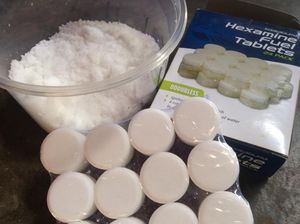Hexamine
Hexamine (or methenamine) is a solid, flammable organic compound that finds a use as a starting point for a few energetic materials. It has the chemical formula C6H12N4 or (CH2)6N4.
Contents
Properties
Chemical
Hexamine burns slowly, without producing smoke or melting. It is an effective reducing agent in energetic mixtures.
It is able to form salts, but at low pH the molecule breaks down into ammonia and formaldehyde.
Reactions with hydrogen peroxide form a very unstable organic peroxide explosive, similar to acetone peroxide, called HMTD.
Mild nitration forms hexamine dinitrate while complete nitration forms the powerful military explosive RDX.
Hexamine can also be reacted with perchloric acid to form the moderately powerful explosive hexamine diperchlorate.
Tablets of hexamine set on fire can be used as heat sources in a home lab. It is included in some chemistry sets for this purpose. You can also buy them, and a simple apparatus for burning them, in a camping or survival store.
Physical
Hexamine is very soluble in water and displays inverse solubility (is less soluble in hot water than cold). It is also soluble in chloroform, ethanol, methanol, slightly soluble in acetone, propanol, isopropanol, butanol, isobutanol, pentanol, tert-amyl alcohol and poorly soluble in benzene, benzyl alcohol, carbon disulfide, carbon tetrachloride, cyclohexanone, decahydronaphthalene, diethyl ether, 1,4-dioxane, isoamyl alcohol, tetrachloroethane, trichloroethene, toluene, xylene and practically insoluble in glycerol, petroleum ether. The solid and solutions have a mild smell akin to fish, or cat food, which some people find this quite unpleasant.
It is similar to the superbase DABCO, mainly in structure and physical properties.
Availability
Hexamine is widely used in camping fuel tablets, either pure or mixed with 1,3,5-trioxane. In both cases, a wax binding covers the small tablets, requiring the hexamine to be dissolved in water and the binders filtered off before use.
Preparation
Combinations of ammonia and formaldehyde create very pure hexamine, and the solution can be boiled to expel excess ammonia or fomaldehyde and to crystallize out the soluble hexamine. Hexamine can be further purified by sublimating it at high heat and depositing it on a cool surface. This can be accomplished with a bucket, a lid, and a heating source.
Projects
- RDX synthesis
- HMTD synthesis
- Lithium perchlorate-hexamine rocket fuel
Handling
Safety
Hexamine is not terribly toxic, so its major hazard comes from its high flammability. Also, because it does not melt or produce smoke while burning, it can be difficult to tell that samples are actually on fire, leading to accidental burns.
Storage
Hexamine should be stored in closed bottles, at room temperature or lower.
Disposal
Hexamine can be safely burned.

